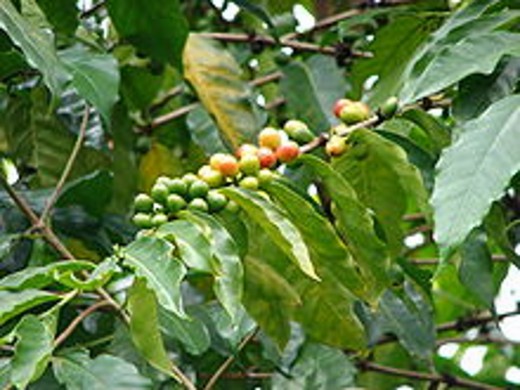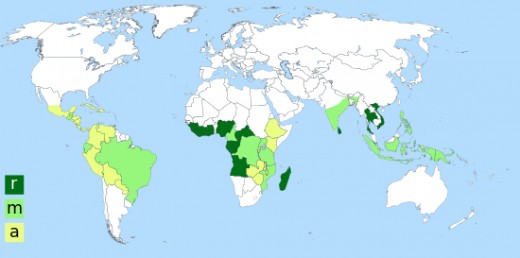Favorite Cuppa
Coffea arabica

Coffee is a powder that is made by roasting and grinding the seeds obtained from certain trees, such as Coffea arabica, Coffea robusta, and others, which belong to the wider madder plant family, a genus (Rubia) of about 80 species of perennial plants distributed throughout Africa, the Americas, Asia and the Mediterranean. Coffee is one of the most widely consumed substances in the world, usually being taken after being mixed with water or some other liquid. Coffee contains hundreds of different substances, the most commonly known one of these substances being caffeine, a psychoactive alkaloid that also occurs naturally in cocoa, tea and cola nuts. Caffeine is the most commonly consumed psychoactive substance, i.e. a substance that affects the brain influencing behavior and heightening sensitivity, in the world and coffee consumption provides a very substantial chunk of the caffeine that humans consume.
For a very long time in the past, it used to be thought that the consumption of coffee, especially in large quantities had more deleterious effects on the consumer than positive effects and the beverage had been linked with such diverse conditions from cancers to heart disease. More recent research, however, has shown that many of the fears associated with coffee consumption have been exaggerated at least and that many of the ills that have been formerly associated with coffee may be better ascribed to other lifestyle aspects of the coffee drinkers’ life. Indeed, much of the research finding that has surfaced in the last several years indicates that rather than being a threat to health, coffee, taken in reasonable amounts, might actually actively aid healthy living.
Coffee Black!

Not so unhealthy, after all!
For a very long time in the past, it used to be thought that the consumption of coffee, especially in large quantities had more deleterious effects on the consumer than positive effects and the beverage had been linked with such diverse conditions from cancers to heart disease. More recent research, however, has shown that many of the fears associated with coffee consumption have been exaggerated at least and that many of the ills that have been formerly associated with coffee may be better ascribed to other lifestyle aspects of the coffee drinkers’ life. Indeed, much of the research finding that has surfaced in the last several years indicates that rather than being a threat to health, coffee, taken in reasonable amounts, might actually actively aid healthy living.
Caffeine, for instance, is not just a means of staying awake at boring meetings or staying up late to prepare for tomorrow’s examinations; more recent finding indicate that the consumption of caffeine in reasonable amounts can actually aid intelligence, or something close to that.
As we saw above, caffeine is a psychoactive substance and its primary method in affecting the brain is by blocking the effects of one of the inhibitory neurotransmitters, chemicals which facilitate the passage of impulses between nerve fibers or between nerve fibers and muscles, called adenosine. By blocking the inhibitory effects of adenosine, caffeine actually increases neuronal firing in the brain and the release of other neurotransmitters like dopamine and norepinephrine which have a more stimulatory effect on people and a number of controlled tests have shown that caffeine does improve mood, reaction time, memory, vigilance and general cognitive function.
Caffeine also plays a positive role in weight loss/ weight maintenance because as it operates upon the central nervous system, it increases the body's metabolism and speeds up the oxidation of fatty acids in the body. Further, its ability to mobilize the body's reserves of fatty acids means that caffeine can enhance physical performance and it is therefore no surprise that caffeine is an ingredient in most preparations which are legally permissible for enhancing sporting ability as well as in those that are designed to help to lose weight. In fact, the World Anti-Doping Agency removed caffeine from a list of banned performance enhancers in 2004 though it ought to be kept in mind that in the case of enhancing physical performance, caffeine works better for those who do not usually use it than it does for those who are regular consumers.
Coffee also seems to play a positive role in other health related issues. Studies have shown that drinking coffee seems to reduce the risk of developing Type II diabetes as well as reduce the risk of developing Parkinson's and Alzheimer's diseases. Indeed studies indicate that drinking coffee is associated with an overall reduction in the risk of death from all causes.
For instance, two studies, the Epidemiology of Caffeine Consumption and Association of Coffee Drinking with Total and Cause-Specific Mortality [see the Journal of Caffeine Research, December 2012, 2(4): 153-158] and the Association of coffee drinking with total and cause-specific mortality [see the New England Journal of Medicine 2012 May 17; 366(20):1891-904] found that there was an inverse relationship between coffee consumption of coffee and the risk of overall death as well as with the risk of death from certain specific causes such as cirrhosis and cancer of the liver with the relationship increasing with the amount of coffee consumed.
Then there is the fact that contrary to received knowledge, coffee contains a decent amount of several vitamins and minerals and it is also the biggest single source of antioxidants in modern western diet providing appreciable proportions of the recommended daily allowance of such requirements as vitamin B5 (Pantothenic Acid); vitamin B3 (Niacin); potassium and manganese; amongst others
Shortcomings? Well, quite a few.
So, if coffee is really this wonderful what, if any, are the downsides. Well, the first thing to keep in mind is that moderation is the keyword as it is, or should be, in all that one does. Most of the research is based on moderate consumption of the beverage, i.e. between 3 and 6 cups of coffee a day, and the beverage used for research purposes is generally black coffee or coffee that has only limited amounts of milk and/or sugar. Additionally, a research “cup” typically contains less than a quarter of a liter of the beverage (about 8 fluid ounces) which contains about 100 mg of caffeine. This is a very important point, for the large sized offerings that are offered in many commercial outlets, e.g. Starbucks Grande coffee, has twice the liquid content of the research cup and more than three times its caffeine content (about 330mg of caffeine). There is also the calorific value of commercially available offerings. A three quarter liter (24 fluid ounces) Starbucks mocha Frappachino with whipped cream contains not only much more caffeine than has been considered in the studies, it has almost 500 calories. Coffee drinkers may not be aware that even just the one “cup” of the beverage daily that they consume can add so much to their energy intake and, if they fail to compensate for the added calories by consuming less over the course of the day, they run a risk of putting on unwanted additional weight over time. Such weight gain can also increase the risk of developing type II diabetes over time.
There is also the problem of the general lifestyle of the coffee drinker. Too often, coffee drinking is associated with other lifestyle choices that may not be the best, to put it mildly. Coffee drinkers as a group tend to smoke more, exercise less and eat a less health-conscious diet than most other groups and it is possible that any benefits that the beverage might confer are overwhelmed by bad effects of other habits. Indeed, many experts today are of the view that the links that many old studies found between coffee and many ills reached those conclusions because such studies not properly calibrated to take account the effects of other life-style factors.
Then there is the problem that whilst studies show beneficial effects for caffeine consumption, not all such benefits are replicated when one drinks coffee. As we saw earlier, the composition of coffee is extremely complex so that it is possible that other compounds in the beverage may have a counteracting effect upon caffeine when taken together in the same beverage. More research will have to be done in order to better understand this area.
The type of coffee that one drinks also plays a role in how healthful or otherwise it can be. Cafestol, a substance which stimulates the production of LDL cholesterol, is one of the substances contained in coffee. It is mainly concentrated in the oily fraction of the coffee so that if coffee is brewed using a paper filter(or if one takes instant coffee) most of the cafestol is avoided. This is important for people who have problems with cholesterol levels as other methods such as boiling, French press coffee and Turkish coffee typically exhibit much higher levels of the substance than do paper filtered or instant coffee.
Certain categories of people may be more likely to have a negative reaction to coffee. Pregnant women are very much at risk because caffeine passes through the placenta and reaches the fetus which is extremely sensitive to the substance. Also, as pregnancy progresses, it takes a longer time for the body to metabolize the caffeine; the half-life of caffeine in an adult is somewhere between 3 and 6 hours depending on age and other factors, but by the end of pregnancy this may have increased to ten hours or more. It is even more drastic for the fetus because the fetus lacks the liver enzymes CYP1A2 and CYP1A1 it is only able to metabolize caffeine very slowly and the half-life of the substance in the fetus can be up to twice as long as it is in the mother. Given these factors, it seems advisable that pregnant women restrict consumption to no more than a cup a day, if they have to consume at all. It is not clear whether exposure of the fetus to caffeine increases the risks of a miscarriage but a large study in Denmark in 2003 indicates that increased levels of coffee consumption amongst pregnant women led to a higher risk of stillbirths; studies are ongoing, but it seems prudent to reduce or stop coffee during pregnancy. Even after baby has been born, it may be useful to restrict coffee consumption for some time. Coffee contains substances known as polyphenols which interfere with the ability of nursing mums, and consequently the nursing child, to absorb iron efficiently which can lead to iron deficiency anemia.
In addition to pregnant women, the very young, the aged, hypertensive folk, as well as those who have trouble controlling their blood sugar may do very well to avoid coffee, or perhaps make do with the decaffeinated variety. The inclusion of folk who have difficulty controlling their blood sugar in this group is one of the paradoxes that surrounds coffee. Although, as we saw above, studies have shown that coffee consumption reduces the risk of developing type II diabetes some acute studies that just give people caffeine or caffeinated coffee, and then have them eat something rich in glucose, have shown that their sensitivity to insulin drops and their blood glucose levels are higher than expected.
Caffeine may also have adverse effects when combined with some other drugs. In combination with certain analgesics such as Paracetemol and Acetaminophen, it has been implicated in liver damage. Certain antibiotics, e.g. ciprofloxacin and norfloxacin, inhibit the metabolization of caffeine which means that caffeine stays longer in the body than it normally would thereby amplifying any of its unwanted caffeine effects and nullifying partly or completely its beneficial effects.
Then, there is the fact that caffeine is an addictive substance. Excessive intake of caffeine can cause physical and psychological addiction and because people have different tolerance levels for various substances, the issue of what is the right amount to consume will differ from one person to another. Studies carried out at by Roland Griffiths of the Johns Hopkins School of Medicine and Laura Juliano of the American University and reported in the October 2004 issue of the Psychopharmacology journal have shown that even as little as 100mg of caffeine (just the one “cup”) a day can lead to physical addiction that would trigger withdrawal symptoms that include headaches, muscle pain and stiffness, lethargy, nausea, vomiting, depressed mood, and marked irritability. Withdrawal symptoms can manifest within 12 to 24 hours after stopping consumption and can last for up to nine days.
Related to the problem of addiction is the phenomenon known as caffeine intoxication. Taking over 300 mg ( approximately 3 cups of espresso ) of caffeine daily over a long period of time may over stimulate the nervous system and produce nervousness, a flushed face, muscle twitching, irregular and/or rapid heartbeat (tachycardia), and rambling thoughts and speech. Both caffeine intoxication and addiction are now classified as mental disorders in the US. Intoxication was added to the list of mental disorders in DSM-IV (American Psychiatric Association's Diagnostic and Statistical Manual of Mental Disorders), whilst addiction has been added in DSM-V.
So, each coffee drinker will have to determine what constitutes too much coffee taking into account all of his/her circumstances. For most healthy adults, 2 to 4 cups (about 300mg of caffeine) ought not to pose any health risks; indeed, such usage may provide certain health benefits. Heavy usage (500mg or more of caffeine daily), on the other hand, may pose some problems. Certainly, if one begins to develop such symptoms as nervousness, insomnia, muscle tremors, etc., it may be time to reassess one's coffee regimen, perhaps even to seek professional help. It should also be kept in mind that some people are more sensitive to caffeine than the general run of the population so that even a cup a day may be courting trouble. Health Canada recommends that healthy adults should limit their caffeine intake to no more than 400mg daily whilst women of childbearing age should limit themselves to no more than 300mg.
Be Reasonable!
So, just be reasonable and go on, have that cuppa!
Another Coffee, Please!

Areas of coffee cultivation by types of coffee.

a
| r
| m
|
|---|---|---|
Coffea arabica
| Coffea robusta
| Both varieties
|
Map Legend






